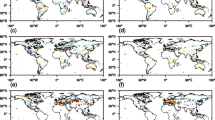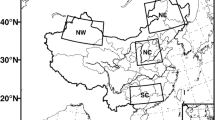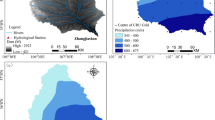Abstract
The future vegetation–climate system over East Asia, as well as its dependence on Representative Concentration Pathways (RCPs), is investigated using a regional climate–vegetation model driven with boundary conditions from Flexible Global Ocean–Atmosphere–Land System Model: Grid-point Version 2. Over most of the region, due to the rising CO2 concentration and climate changes, the model projects greater vegetation density (leaf area index) and gradual shifts of vegetation type from bare ground to grass or from grass to trees; the projected spatial extent of the vegetation shift increases from RCP2.6 to RCP8.5. Abrupt shifts are projected under RCP8.5 over northeast China (with grass replacing boreal needleleaf evergreen trees due to heat stress) and India (with tropical deciduous trees replacing grass due to increased water availability). The impact of vegetation feedback on future precipitation is relatively weak, while its impact on temperature is more evident, especially during DJF over northeast China and India with differing mechanisms. In northeast China, the projected forest loss induces a cooling through increased albedo, and daytime high temperature (Tmax) is influenced more than nighttime low temperature (Tmin); in India, increased vegetation cover induces an evaporative cooling that outweighs the warming effect of an albedo decrease in DJF, leading to a weaker impact on Tmax than on Tmin. Based on a single model, the qualitative aspects of these results may hold while quantitative assessment will benefit from a follow-up regional model ensemble study driven by multiple general circulation models.











Similar content being viewed by others
References
Alkama R, Cescatti A (2016) Biophysical climate impacts of recent changes in global forest cover. Science 351:600–604. https://doi.org/10.1126/science.aac8083
Alo CA, Wang G (2008) Potential future changes of the terrestrial ecosystem based on climate projections by eight general circulation models. J Geophys Res-Biogeo. https://doi.org/10.1029/2007jg000528
Betts RA (2000) Offset of the potential carbon sink from boreal forestation by decreases in surface albedo. Nature 408:187–190. https://doi.org/10.1038/35041545
Bonan GB (2008) Forests and climate change: forcings, feedbacks, and the climate benefits of forests. Science 320:1444–1449. https://doi.org/10.1126/science.1155121
Bonan GB, Doney SC (2018) Climate, ecosystems, and planetary futures: the challenge to predict life in Earth system models. Science 359:eaam8328. https://doi.org/10.1126/science.aam8328
Charney JG (1975) Dynamics of deserts and drought in the Sahel. Q J R Meteor Soc 101:193–202. https://doi.org/10.1002/qj.49710142802
Chen C et al (2019) China and India lead in greening of the world through land-use management. Nat Sustain 2:122–129. https://doi.org/10.1038/s41893-019-0220-7
Cox PM, Betts RA, Jones CD, Spall SA, Totterdell IJ (2000) Acceleration of global warming due to carbon-cycle feedbacks in a coupled climate model. Nature 408:184–187. https://doi.org/10.1038/35041539
Cramer W et al (2001) Global response of terrestrial ecosystem structure and function to CO2 and climate change: results from six dynamic global vegetation models. Glob Chang Biol 7:357–373. https://doi.org/10.1046/j.1365-2486.2001.00383.x
Dan L, Cao F, Gao R (2015) The improvement of a regional climate model by coupling a land surface model with eco-physiological processes: a case study in 1998. Clim Change 129:457–470. https://doi.org/10.1007/s10584-013-0997-8
Davin EL, de Noblet-Ducoudré N (2010) Climatic impact of global-scale deforestation: radiative versus nonradiative processes. J Clim 23:97–112. https://doi.org/10.1175/2009JCLI3102.1
Duveiller G, Hooker J, Cescatti A (2018) The mark of vegetation change on Earth’s surface energy balance. Nat Commun 9:679. https://doi.org/10.1038/s41467-017-02810-8
Emanuel KA (1991) A scheme for representing cumulus convection in large-scale models. J Atmos Sci 48:2313–2329. https://doi.org/10.1175/1520-0469(1991)048%3c2313:Asfrcc%3e2.0.Co;2
Erfanian A, Wang G (2018) Explicitly accounting for the role of remote oceans in regional climate modeling of South America. J Adv Model Earth Syst 10:2408–2426. https://doi.org/10.1029/2018ms001444
Erfanian A, Wang G, Yu M, Anyah R (2016) Multimodel ensemble simulations of present and future climates over West Africa: impacts of vegetation dynamics. J Adv Model Earth Syst 8:1411–1431. https://doi.org/10.1002/2016MS000660
Franklin J, Serra-Diaz JM, Syphard AD, Regan HM (2016) Global change and terrestrial plant community dynamics. Proc Natl Acad Sci USA 113:3725–3734. https://doi.org/10.1073/pnas.1519911113
Gang C et al (2017) Modeling the dynamics of distribution, extent, and NPP of global terrestrial ecosystems in response to future climate change. Glob Planet Change 148:153–165. https://doi.org/10.1016/j.gloplacha.2016.12.007
Gao X, Xu Y, Zhao Z, Pal JS, Giorgi F (2006) On the role of resolution and topography in the simulation of East Asia precipitation. Theor Appl Climatol 86:173–185. https://doi.org/10.1007/s00704-005-0214-4
Gibbard S, Caldeira K, Bala G, Phillips T, Wickett M (2005) Climate effects of global land cover change. Geophys Res Lett. https://doi.org/10.1029/2005GL024550
Giorgi F et al (2012) RegCM4: model description and preliminary tests over multiple CORDEX domains. Clim Res 52:7–29. https://doi.org/10.3354/cr01018
Gotangco Castillo CK, Levis S, Thornton P (2012) Evaluation of the new CNDV option of the community land model: effects of dynamic vegetation and interactive nitrogen on CLM4 means and variability*. J Clim 25:3702–3714. https://doi.org/10.1175/jcli-d-11-00372.1
He C, Zhou T (2015) Responses of the Western North Pacific subtropical high to global warming under RCP4.5 and RCP8.5 scenarios projected by 33 CMIP5 models: the dominance of tropical indian ocean-tropical Western Pacific SST gradient. J Clim 28:365–380. https://doi.org/10.1175/jcli-d-13-00494.1
Henderson-Sellers A, Dickinson RE, Durbidge TB, Kennedy PJ, McGuffie K, Pitman AJ (1993) Tropical deforestation: modeling local- to regional-scale climate change. J Geophys Res-Atmos 98:7289–7315. https://doi.org/10.1029/92jd02830
Higgins PAT, Harte J (2006) Biophysical and biogeochemical responses to climate change depend on dispersal and migration. BioScience. https://doi.org/10.1641/0006-3568(2006)056%5b0407:Babrtc%5d2.0.Co;2
Holtslag AAM, De Bruijn EIF, Pan HL (1990) A high resolution air mass transformation model for short-range weather forecasting. Mon Weather Rev 118:1561–1575. https://doi.org/10.1175/1520-0493(1990)118%3c1561:Ahramt%3e2.0.Co;2
Hua W, Chen H, Sun S, Zhou L (2015) Assessing climatic impacts of future land use and land cover change projected with the CanESM2 model. Int J Climatol 35:3661–3675. https://doi.org/10.1002/joc.4240
Hua W et al (2017) Observational quantification of climatic and human influences on vegetation greening in China. Remote Sens. https://doi.org/10.3390/rs9050425
IPCC (2013) Climate change 2013: the physical science basis. In: Stocker TF et al (eds) Contribution of working group I to the fifth assessment report of the intergovernmental panel on climate change. Cambridge University Press, Cambridge
Jeong SJ, Ho CH, Jeong JH (2009a) Increase in vegetation greenness and decrease in springtime warming over east Asia. Geophys Res Lett. https://doi.org/10.1029/2008GL036583
Jeong SJ, Ho CH, Kim KY, Jeong JH (2009b) Reduction of spring warming over East Asia associated with vegetation feedback. Geophys Res Lett. https://doi.org/10.1029/2009GL039114
Kang S, Eltahir EAB (2018) north China Plain threatened by deadly heatwaves due to climate change and irrigation. Nat Commun 9:2894. https://doi.org/10.1038/s41467-018-05252-y
Kiehl JT, Hack JJ, Bonan GB, Boville BA, Briegleb BP, Williamson DL, Rasch PJ (1996) Description of the NCAR community climate model (ccm3). https://doi.org/10.5065/D6FF3Q99
Lawrence PJ, Chase TN (2007) Representing a new MODIS consistent land surface in the Community Land Model (CLM 3.0). J Geophys Res 112:252–257. https://doi.org/10.1029/2006jg000168
Lawrence D, Vandecar K (2015) Effects of tropical deforestation on climate and agriculture. Nat Clim Change 5:27–36. https://doi.org/10.1038/nclimate2430
Lawrence DM et al (2011) Parameterization improvements and functional and structural advances in version 4 of the community land model. J Adv Model Earth Syst. https://doi.org/10.1029/2011MS00045
Lehsten V, Mischurow M, Lindström E, Lehsten D, Lischke H (2019) LPJ-GM 1.0: simulating migration efficiently in a dynamic vegetation model. Geosci Model Dev 12:893–908. https://doi.org/10.5194/gmd-12-893-2019
Li L et al (2013) The flexible global ocean-atmosphere-land system model, Grid-point Version 2: FGOALS-g2. Adv Atmos Sci 30:543–560. https://doi.org/10.1007/s00376-012-2140-6
Li Y, Zhao M, Motesharrei S, Mu Q, Kalnay E, Li S (2015) Local cooling and warming effects of forests based on satellite observations. Nat Commun 6:6603. https://doi.org/10.1038/ncomms7603
Li D, Zhou T, Zou L, Ma S (2016) Simulated and projected surface air temperature over China in RegCM3 CORDEX East Asia experiments. Chin J Atmos Sci (in Chinese) 41:544–560. https://doi.org/10.3878/j.issn.1006-9895.1607.16153
Li X et al (2017) Potential effects of land cover change on temperature extremes over Eurasia: current versus historical experiments. Int J Climatol 37:59–74. https://doi.org/10.1002/joc.4976
Li D, Zou L, Zhou T (2018) Extreme climate event changes in China in the 1.5 and 2 & #xB0;C warmer climates: results from statistical and dynamical downscaling. J Geophys Res-Atmos 123:10215–10230. https://doi.org/10.1029/2018jd028835
Liu Y, Stanturf J, Lu H (2008) Modeling the potential of the Northern China forest shelterbelt in improving hydroclimate conditions1. JAWRA 44:1176–1192. https://doi.org/10.1111/j.1752-1688.2008.00240.x
Ma D, Notaro M, Liu Z, Chen G, Liu Y (2013) Simulated impacts of afforestation in East China monsoon region as modulated by ocean variability. Clim Dyn 41:2439–2450. https://doi.org/10.1007/s00382-012-1592-9
Mahowald N, Lo F, Zheng Y, Harrison L, Funk C, Lombardozzi D, Goodale C (2016) Projections of leaf area index in earth system models. Earth Syst Dyn 7:211–229. https://doi.org/10.5194/esd-7-211-2016
Mao J et al (2016) Human-induced greening of the northern extratropical land surface. Nat Clim Change 6:959–963. https://doi.org/10.1038/nclimate3056
Melillo J, McGuire D, Kicklighter DW, Moore B, Vorosmarty C, Schloss AL (1993) Global climate change and terrestrial net primary production. Nature 363:234–240. https://doi.org/10.1038/363234a0
Moss RH et al (2010) The next generation of scenarios for climate change research and assessment. Nature 463:747–756. https://doi.org/10.1038/nature08823
Murray-Tortarolo G et al (2013) Evaluation of land surface models in reproducing satellite-derived LAI over the high-latitude northern hemisphere. Part I: uncoupled DGVMs. Remote Sens 5:4819–4838. https://doi.org/10.3390/rs5104819
Nemani RR et al (2003) Climate-driven increases in global terrestrial net primary production from 1982 to 1999. Science 300:1560–1563. https://doi.org/10.1126/science.1082750
Niu X, Tang J, Wang S, Fu C (2018) Impact of future land use and land cover change on temperature projections over East Asia. Clim Dyn. https://doi.org/10.1007/s00382-018-4525-4
Notaro M, Liu Z (2008) Statistical and dynamical assessment of vegetation feedbacks on climate over the boreal forest. Clim Dyn 31:691–712. https://doi.org/10.1007/s00382-008-0368-8
Notaro M, Chen G, Liu Z (2011) Vegetation feedbacks to climate in the global monsoon regions*. J Clim 24:5740–5756. https://doi.org/10.1175/2011jcli4237.1
Notaro M, Chen G, Yu Y, Wang F, Tawfik A (2017) Regional climate modeling of vegetation feedbacks on the Asian–Australian monsoon systems. J Clim 30:1553–1582. https://doi.org/10.1175/JCLI-D-16-0669.1
Oleson KW et al (2010) Technical description of version 4.0 of the Community Land Model (CLM). NCAR Technical Note NCAR/TN-478 + STR. https://doi.org/10.5065/d6fb50wz
Oleson K et al (2013) Technical description of version 4.5 of the Community Land Model (CLM). Ncar Technical Note NCAR/TN-503 + STR. https://doi.org/10.5065/d6rr1w7m
Peng S et al (2013) Asymmetric effects of daytime and night-time warming on Northern Hemisphere vegetation. Nature 501:88. https://doi.org/10.1038/nature12434
Shen M et al (2015) Evaporative cooling over the Tibetan Plateau induced by vegetation growth. Proc Natl Acad Sci USA 112:9299–9304. https://doi.org/10.1073/pnas.1504418112
Shi Y, Wang G, Gao X (2017) Role of resolution in regional climate change projections over China. Clim Dyn 51:2375–2396. https://doi.org/10.1007/s00382-017-4018-x
Shi Y, Yu M, Erfanian A, Wang G (2018) Modeling the dynamic vegetation–climate system over china using a coupled regional model. J Clim 31:6027–6049. https://doi.org/10.1175/jcli-d-17-0191.1
Taylor KE, Stouffer RJ, Meehl GA (2012) An overview of CMIP5 and the experiment design. Bull Am Meteor Soc 93:485–498. https://doi.org/10.1175/bams-d-11-00094.1
Tharammal T, Bala G, Narayanappa D, Nemani R (2018) Potential roles of CO2 fertilization, nitrogen deposition, climate change, and land use and land cover change on the global terrestrial carbon uptake in the twenty-first century. Clim Dyn 52:4393–4406. https://doi.org/10.1007/s00382-018-4388-8
Wang L, Chen W (2014) A CMIP5 multimodel projection of future temperature, precipitation, and climatological drought in China. Int J Climatol 34:2059–2078. https://doi.org/10.1002/joc.3822
Wang G, Eltahir EA (2000a) Ecosystem dynamics and the Sahel Drought. Geophys Res Lett 27:795–798. https://doi.org/10.1029/1999gl011089
Wang G, Eltahir EA (2000b) Role of vegetation dynamics in enhancing the low-frequency variability of the Sahel rainfall. Water Resour Res 36:1013–1021. https://doi.org/10.1029/1999WR900361
Wang G, Eltahir EAB, Foley JA, Pollard D, Levis S (2004) Decadal variability of rainfall in the Sahel: results from the coupled GENESIS-IBIS atmosphere-biosphere model. Clim Dyn 22:625–637. https://doi.org/10.1007/s00382-004-0411-3
Wang G, Yu M, Pal JS, Mei R, Bonan GB, Levis S, Thornton PE (2016) On the development of a coupled regional climate–vegetation model RCM–CLM–CN–DV and its validation in Tropical Africa. Clim Dyn 46:515–539. https://doi.org/10.1007/s00382-015-2596-z
Wang G, Ahmed KF, You L, Yu M, Pal J, Ji Z (2017) Projecting regional climate and cropland changes using a linked biogeophysical-socioeconomic modeling framework: 1. Model description and an equilibrium application over West Africa. J Adv Model Earth Syst 9:354–376. https://doi.org/10.1002/2016ms000712
Wei J, Jin Q, Yang Z-L, Zhou L (2017) Land-atmosphere-aerosol coupling in north China during 2000–2013. Int J Climatol 37:1297–1306. https://doi.org/10.1002/joc.4993
Williams JW, Jackson ST, Kutzbach JE (2007) Projected distributions of novel and disappearing climates by 2100 AD. Proc Natl Acad Sci USA 104:5738–5742. https://doi.org/10.1073/pnas.0606292104
Xue Y, Shukla J (1993) The influence of land surface properties on sahel climate. Part 1: desertification. J Clim 6:2232–2243. https://doi.org/10.1175/1520-0442(1993)006%3c2232:TIOLSP%3e2.0.CO;2
Xue Y, De Sales F, Vasic R, Mechoso CR, Arakawa A, Prince S (2010) Global and seasonal assessment of interactions between climate and vegetation biophysical processes: a GCM study with different land–vegetation representations. J Clim 23:1411–1433. https://doi.org/10.1175/2009jcli3054.1
Yan Y, Tang J, Liu G, Wu J (2019) Effects of vegetation fraction variation on regional climate simulation over Eastern China. Glob Planet Change 175:173–189. https://doi.org/10.1016/j.gloplacha.2019.02.004
Yang W, Long D, Bai P (2019) Impacts of future land cover and climate changes on runoff in the mostly afforested river basin in North China. J Hydrol 570:201–219. https://doi.org/10.1016/j.jhydrol.2018.12.055
Yao R, Wang L, Huang X, Chen X, Liu Z (2019) Increased spatial heterogeneity in vegetation greenness due to vegetation greening in mainland China. Ecol Ind 99:240–250. https://doi.org/10.1016/j.ecolind.2018.12.039
Yu E, Wang H, Sun J, Gao Y (2013) Climatic response to changes in vegetation in the Northwest Hetao Plain as simulated by the WRF model. Int J Climatol 33:1470–1481. https://doi.org/10.1002/joc.3527
Yu M, Wang G, Parr D, Ahmed KF (2014) Future changes of the terrestrial ecosystem based on a dynamic vegetation model driven with RCP8.5 climate projections from 19 GCMs. Clim Change 127:257–271. https://doi.org/10.1007/s10584-014-1249-2
Yu M, Wang GL, Chen HS (2016a) Quantifying the impacts of land surface schemes and dynamic vegetation on the model dependency of projected changes in surface energy and water budgets. J Adv Model Earth Syst 8:370–386. https://doi.org/10.1002/2015ms000492
Yu M, Wang G, Pal JS (2016b) Effects of vegetation feedback on future climate change over West Africa. Clim Dyn 46:1–20. https://doi.org/10.1007/s00382-015-2795-7
Yu Y, Notaro M, Wang F, Mao J, Shi X, Wei Y (2017) Observed positive vegetation-rainfall feedbacks in the Sahel dominated by a moisture recycling mechanism. Nat Commun 8:1873. https://doi.org/10.1038/s41467-017-02021-1
Zeng N, Neelin JD, Lau K-M, Tucker CJ (1999) Enhancement of interdecadal climate variability in the Sahel by vegetation interaction. Science 286:1537–1540. https://doi.org/10.1126/science.286.5444.1537
Zeng Z et al (2018) Global terrestrial stilling: does Earth’s greening play a role? Environ Res Lett. https://doi.org/10.1088/1748-9326/aaea84
Zhao W, Hu Z, Guo Q, Wu G, Chen R, Li S (2019) Contributions of climatic factors to inter-annual variability of vegetation index in northern China grasslands. J Clim. https://doi.org/10.1175/jcli-d-18-0587.1
Zhou L, Dickinson RE, Tian Y, Vose RS, Dai Y (2007) Impact of vegetation removal and soil aridation on diurnal temperature range in a semiarid region: application to the Sahel. Proc Natl Acad Sci USA 104:17937–17942. https://doi.org/10.1073/pnas.0700290104
Zhou T, Song F, Chen X (2013) Historical evolution of global and regional surface air temperature simulated by FGOALS-s2 and FGOALS-g2: how reliable are the model results? Adv Atmos Sci 30:638–657. https://doi.org/10.1007/s00376-013-2205-1
Zhu Z et al (2016) Greening of the Earth and its drivers. Nat Clim Change 6:791–795. https://doi.org/10.1038/nclimate3004
Zou L, Zhou T (2013) Near future (2016-40) summer precipitation changes over China as projected by a regional climate model (RCM) under the RCP8.5 emissions scenario: comparison between RCM downscaling and the driving GCM. Adv Atmos Sci 30:806–818. https://doi.org/10.1007/s00376-013-2209-x
Acknowledgements
This study was made possible by a scholarship from the China Scholarship Council that supported Weiguang Liu’s visit to the University of Connecticut. Computational support was made available through an NCAR computing project to the University of Connecticut (UCNN0017). Yu, Chen and Shi were supported by the National Natural Science Foundation of China (41575084, 41625019 and 41805063). Liu acknowledges funding support by the Postgraduate Research and Practice Innovation Program of Jiangsu Province (KYCX18_1013). The authors thank Michael Notaro for his constructive comments on an earlier version of this paper.
Author information
Authors and Affiliations
Corresponding author
Additional information
Publisher's Note
Springer Nature remains neutral with regard to jurisdictional claims in published maps and institutional affiliations.
Electronic supplementary material
Below is the link to the electronic supplementary material.m
Rights and permissions
About this article
Cite this article
Liu, W., Wang, G., Yu, M. et al. Projecting the future vegetation–climate system over East Asia and its RCP-dependence. Clim Dyn 55, 2725–2742 (2020). https://doi.org/10.1007/s00382-020-05411-2
Received:
Accepted:
Published:
Issue Date:
DOI: https://doi.org/10.1007/s00382-020-05411-2




